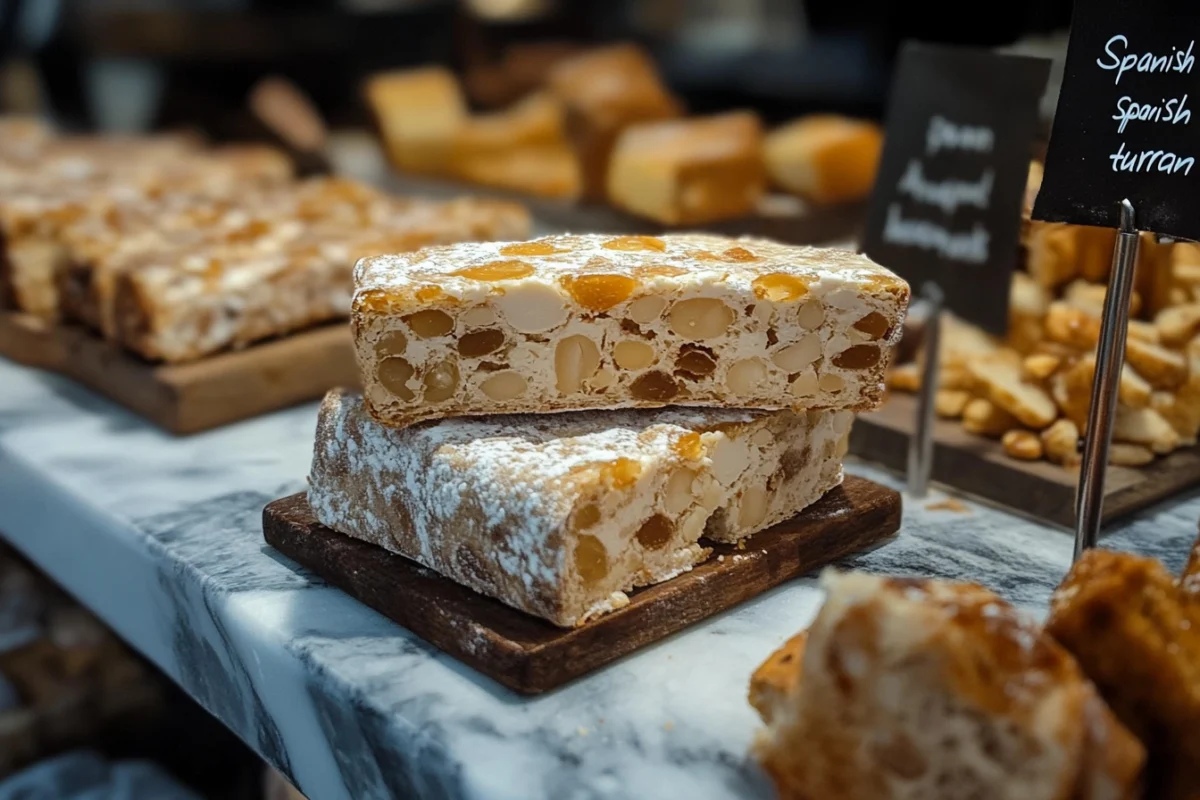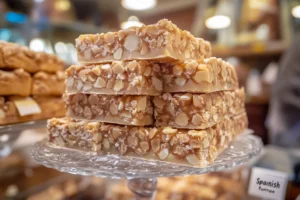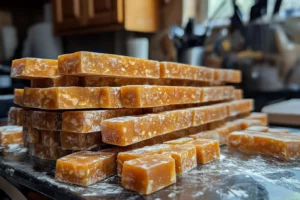Turrón is a traditional Spanish dessert that is especially popular during Christmas. This sweet treat is made from almonds, honey, and sugar. It has a rich cultural history and plays a central role in Spanish holiday celebrations. Turrón is commonly found on festive tables during Christmas and New Year’s Eve.
- Spaniards serve turrón as a dessert or a snack during the festive season.
- The dessert has a distinct texture and flavor that varies based on its type.
- Turrón is often compared to nougat. The difference lies in its use of traditional Spanish ingredients and methods of preparation.
In short, Spanish turrón is not just a sweet; it is an essential part of the Spanish holiday culture.
For those interested in exploring other regional specialties, you can read about the Ultimate Guide to Turrón: History, Recipes & Health Benefits, which dives deeper into the history and various recipes associated with turrón.
History of Turrón
Turrón’s origins date back to ancient times, likely influenced by the Arabic presence in Spain. Over the centuries, it has evolved into one of the most cherished desserts, particularly at Christmas.
- Arabic Influence: The Moors introduced sugar and almonds to Spain, which inspired early versions of turrón.
- Evolution into a Christmas Tradition: Turrón became closely tied to Spanish Christmas traditions and began to be consumed mainly during this season.
- Regional Variations: Different regions in Spain have unique recipes for turrón, such as Turrón de Jijona and Turrón de Alicante.
Turrón has become a symbol of family gatherings and celebration in Spain. It underscores the importance of tradition and food in Spanish culture.
The Ingredients of Turrón
The basic ingredients of turrón are simple yet flavorful. They include almonds, sugar, honey, and sometimes egg whites or chocolate. These ingredients create the dessert’s unique texture and sweetness.
- Almonds: This key ingredient gives turrón its nutty flavor and crunch. The type of almonds used, whether roasted or raw, can influence the texture.
- Honey: Honey adds natural sweetness and acts as a binding agent.
- Sugar: Sugar enhances the sweetness and helps with consistency.
- Egg Whites (optional): Used in hard turrón recipes, egg whites create a firm texture.
- Chocolate (optional): Chocolate turrón adds a rich twist to the traditional recipe.
Recently, variations like vegan turrón have emerged. These versions substitute honey with agave syrup and exclude egg whites, making the treat suitable for plant-based diets.
These simple ingredients form the base of every turrón recipe. The proportions and preparation methods vary, resulting in different textures, from soft to hard.
Types of Spanish Turrón
Turrón Blando (Soft Turrón)
Turrón Blando is one of the most popular varieties of Spanish turrón. It is characterized by its soft, smooth texture and rich flavor. The primary ingredients include almonds, honey, and sugar, but egg whites also play a role in achieving its creamy consistency.
- Texture and Flavor: Turrón Blando has a chewy and smooth consistency, making it easy to bite into.
- Ingredients: It typically uses ground almonds, which give it a finer texture compared to other types of turrón.
- Regions: This variety is most commonly found in Jijona (a town in the Alicante region), which is known for producing some of the best turrón.
Recipe for Turrón Blando: The process involves roasting almonds, mixing them with honey and sugar, and setting the mixture into molds. The egg whites are added to achieve a smooth texture.
Turrón Duro (Hard Turrón)
Turrón Duro is the harder and crunchier cousin of Turrón Blando. It is made with whole almonds and egg whites, giving it a firmer texture. This variety is often favored for its crunch and the crackling sound when you bite into it.
- Texture and Flavor: Turrón Duro has a crisp, hard texture, making it perfect for those who enjoy a more substantial bite.
- Ingredients: Whole roasted almonds are mixed with sugar and egg whites, which give it a distinct texture and flavor.
- Regions: Turrón de Alicante is one of the most famous examples of this type. It is widely regarded as one of the finest varieties of Turrón Duro.
Recipe for Turrón Duro: The process involves mixing sugar and egg whites to create a meringue-like base, then adding roasted almonds. The mixture is spread into a mold and allowed to set.
To explore another popular yet versatile snack, you might be interested in learning about corn nuggets recipes for a unique variation of comfort food that has become a staple in many households.
Other Types of Turrón
- Chocolate Turrón: This version is made by combining chocolate with the traditional almond-based ingredients. It’s perfect for chocolate lovers and provides a richer flavor than the classic varieties.
- Ingredients: Chocolate, almonds, sugar, and honey.
- Flavor Profile: It has a creamy, chocolaty flavor with the crunch of almonds.
- Vegan Turrón: This modern version removes animal products, offering a plant-based alternative. Agave syrup replaces honey, and egg whites are omitted.
- Ingredients: Almonds, agave syrup, sugar, and sometimes cocoa for flavor.
- Health Benefits: It is suitable for those following a vegan or gluten-free diet.
- Turrón de Yema: A unique variety made with egg yolks, this version is rich and creamy. It has a yellowish hue and a distinct flavor.
- Ingredients: Egg yolks, sugar, almonds, and honey.
- Texture: Creamy and rich, it is softer than the typical hard turrón.
- Turrón de Frutas Secas: This variety includes dried fruits, such as raisins and dried apricots, along with the usual almond base. It provides a fruity twist on the traditional recipe.
- Ingredients: Dried fruits, almonds, honey, and sugar.
- Flavor Profile: Sweet with the natural tang of dried fruits, balanced by the nutty crunch of almonds.
- Turrón de Jijona: A soft, creamy turrón made from ground almonds, honey, and sugar. It is famous for its smooth texture and rich flavor, making it a popular choice during the holidays.
- Ingredients: Ground almonds, honey, sugar, and egg whites.
- Texture: It has a creamy, almost melt-in-your-mouth consistency.
- Turrón de Alicante: Known for its crunchy texture, Turrón de Alicante is made with whole almonds and sugar. It is one of the most recognized and loved varieties of hard turrón.
- Ingredients: Whole almonds, sugar, egg whites.
- Texture: Crisp, hard, and crunchy.
How to Make Turrón at Home
Basic Recipe for Turrón
Making turrón at home can be an enjoyable and rewarding experience. The process is straightforward, and with a few simple ingredients, you can prepare your own Spanish turrón. Here’s a basic recipe for making both Turrón Blando (soft turrón) and Turrón Duro (hard turrón).
Ingredients (for both types)
- Almonds (whole for hard turrón, ground for soft turrón)
- Honey (about 100g)
- Sugar (200g)
- Egg whites (for hard turrón, optional for soft turrón)
- Vanilla extract (optional for flavor)
Instructions:
- Roasting Almonds:
- For both types of turrón, start by roasting the almonds at 160°C (320°F) for about 10-12 minutes. This enhances their flavor and aroma. Allow the almonds to cool.
- Making the Meringue (for Hard Turrón):
- Whisk the egg whites until stiff peaks form. This will help give the turrón a crunchy texture.
- In a separate saucepan, heat the sugar and honey over low heat until the sugar dissolves and the mixture thickens.
- Combining the Ingredients:
- For Turrón Blando: Mix the ground almonds with the warm honey-sugar mixture. Stir until everything is well incorporated. Pour the mixture into a mold lined with parchment paper.
- For Turrón Duro: Mix the roasted whole almonds with the meringue and honey-sugar mixture. Pour into a mold and press it down firmly to compact the ingredients.
- Setting the Turrón:
- Let the turrón cool at room temperature for several hours or overnight. The mixture should set and harden.
- Serving:
- Once set, cut the turrón into slices or bars. Store it in an airtight container to maintain freshness.
Variations and Additions
If you want to get creative with your turrón, you can add a variety of ingredients to enhance the flavor and texture. Here are a few ideas:
- Chocolate Turrón: Melt some dark or milk chocolate and mix it into the almond-honey mixture for a chocolate twist.
- Vegan Turrón: Replace honey with agave syrup and use a plant-based egg substitute to create a vegan version.
- Fruit and Nut Turrón: Add dried fruits like raisins, cranberries, or apricots to the mix, along with extra roasted almonds or pistachios for a richer flavor.
Tips for Perfecting Your Turrón
Making the perfect turrón requires a bit of patience and precision. Here are a few helpful tips to get the best results:
- Use Fresh Ingredients: Fresh almonds and honey will yield the best flavors. Choose high-quality ingredients to elevate the taste of your turrón.
- Control the Temperature: When heating the honey and sugar, be sure to use a low temperature to prevent the mixture from caramelizing. You want the consistency to be thick, but not burnt.
- Let it Set: Give the turrón enough time to cool and set properly. Rushing this step can affect the texture.
- Storage: Keep your homemade turrón in an airtight container, preferably in a cool, dry place. This will help preserve its freshness for up to two weeks.
Common Mistakes to Avoid
Even though making turrón is relatively simple, there are a few mistakes you should watch out for to ensure your homemade turrón turns out perfectly:
- Overheating the Honey: When cooking the honey and sugar, make sure not to overheat the mixture. If it gets too hot, the turrón can become too hard or sticky.
- Not Using the Right Mold: Choose a mold that is the right size for the amount of turrón you are making. If the mold is too large, the turrón will be too thin; too small, and it won’t set properly.
- Skipping the Cooling Time: Don’t rush the cooling process. Let the turrón rest for at least 4-6 hours, or even overnight, to allow it to firm up.
Health Benefits of Turrón
While turrón is a sweet treat, it also offers several health benefits due to its main ingredient almonds.
- High in Nutrients: Almonds are a great source of healthy fats, protein, fiber, and essential vitamins and minerals, including vitamin E and magnesium.
- Rich in Antioxidants: Almonds contain antioxidants that may help reduce inflammation and improve heart health.
- Energy Boosting: The combination of almonds and honey provides a quick energy boost, making turrón a great snack to enjoy during the holiday season.
However, be mindful of portion sizes, as turrón can be high in calories due to its sugar and nut content.
Turrón in Spanish Culture and Traditions
as a Christmas Tradition
Turrón is deeply embedded in Spanish Christmas traditions. It is often placed on the table alongside other festive treats like marzipan, polvorones, and neulas. The popularity of turrón during the Christmas season has made it a symbol of holiday joy, and it is one of the most anticipated aspects of Spanish holiday cuisine.
- Christmas Celebrations: Turrón is commonly enjoyed on Christmas Eve (Nochebuena) and New Year’s Eve (Nochevieja), where families gather to share festive meals.
- Gift-Giving: In Spain, it is customary to give turrón as part of Christmas gift baskets. These baskets are often filled with various types of turrón, allowing friends and family to taste different varieties.
The consumption of turrón marks the festive spirit of Spain, symbolizing the joy of sharing and celebrating with loved ones.
Turrón in Regional Spanish Cuisine
While turrón is popular throughout Spain, some regions have their own variations and recipes that make their version stand out. The most well-known regions for turrón production are Alicante and Jijona, both located in the Valencian Community.
- Turrón de Alicante: This variety is recognized for its hard texture and large whole almonds. It is a traditional product of Alicante and often considered the finest of the hard turrón varieties.
- Turrón de Jijona: Known for its smooth, creamy texture, this variety is made with ground almonds and is most commonly enjoyed in Jijona, a town famous for its turrón production.
- Other Regional Varieties: Some regions also add their local ingredients, such as pistachios, hazelnuts, or figs, to create unique turrón variations.
Turrón’s importance in regional cuisines speaks to its versatility and the pride that different Spanish communities take in crafting their own versions.
Turrón as a Modern Delicacy
Though traditionally associated with Christmas, turrón has evolved and adapted to contemporary tastes. Many artisans and chefs experiment with new flavors and combinations, expanding the concept of turrón beyond its historical roots.
- Innovations in Flavors: Some chefs have introduced modern takes on turrón, such as matcha turrón, caramelized turrón, and even turrón with exotic fruits.
- Turrón in Fine Dining: High-end restaurants in Spain often serve creative turrón-inspired desserts, blending traditional ingredients with modern culinary techniques.
The adaptability of turrón ensures its place not only in traditional Spanish holiday feasts but also in the evolving world of modern gastronomy.
Frequently Asked Questions (FAQs)
- What is the difference between Turrón Blando and Turrón Duro?
- Turrón Blando (soft turrón) has a creamy, smooth texture and is made with ground almonds. It is soft and chewy, ideal for those who prefer a delicate consistency. On the other hand, Turrón Duro (hard turrón) is crunchy and made with whole almonds, creating a firmer texture.
- Can I make Turrón without egg whites?
- Yes, you can make a version of turrón without egg whites. For example, vegan turrón substitutes egg whites with other ingredients like aquafaba (the liquid from cooked chickpeas) or skips them entirely. The turrón will still maintain a delicious texture with almonds and honey.
- How should I store turrón?
- Turrón should be stored in an airtight container at room temperature, away from direct sunlight and humidity. Proper storage can keep it fresh for up to two weeks. However, it may last even longer if kept in a cool, dry place.
- Can I freeze turrón?
- Freezing turrón is possible, but it is not always recommended. Freezing may alter its texture, particularly for soft turrón. If you do freeze it, ensure it is well-wrapped in plastic wrap and stored in a freezer-safe container.
- Is turrón gluten-free?
- Traditional turrón is gluten-free, as it is primarily made from almonds, honey, and sugar. However, always check for potential cross-contamination or added ingredients like flour in commercial varieties.
Conclusion
Spanish turrón is much more than just a festive dessert; it is a symbol of Spanish cultural heritage and culinary tradition. From its origins in ancient Spain to its place at the heart of modern celebrations, turrón has evolved into a beloved treat that can be enjoyed by all.
Whether you prefer the crunchy Turrón Duro or the smooth Turrón Blando, there’s a variety for everyone. The simple yet delicious ingredients—almonds, honey, and sugar—combine to create a sweet treat that’s rich in history and flavor. Moreover, the adaptability of turrón ensures that it continues to innovate while maintaining its roots in Spanish tradition.
Making turrón at home allows you to share this iconic dessert with friends and family while exploring different recipes and variations. Whether you’re enjoying it during the holidays or creating a modern twist on the classic recipe, turrón will always have a place in the hearts and kitchens of Spanish homes.
The next time you enjoy a bite of turrón, you’ll know it’s not just a dessert; it’s a piece of Spain’s rich cultural legacy.



